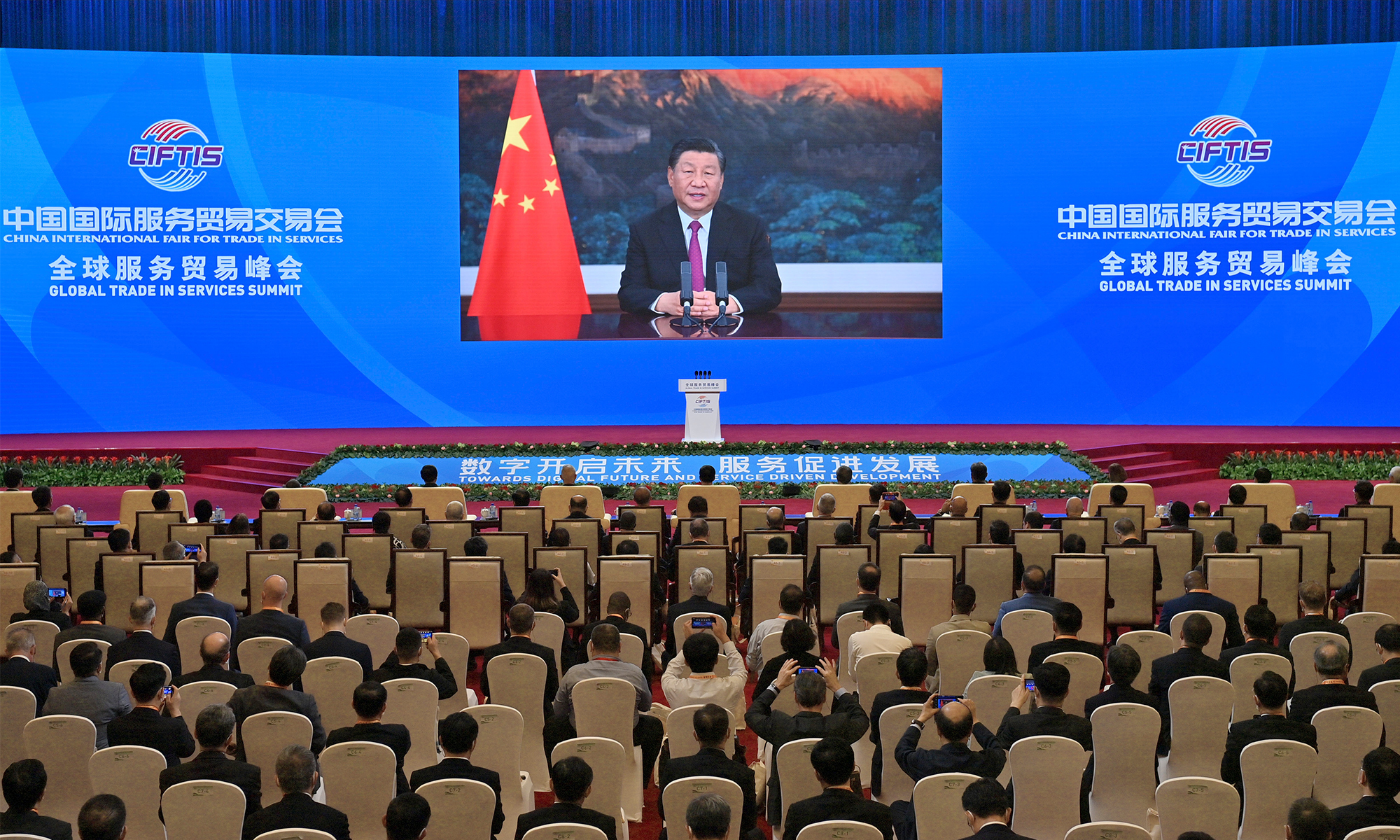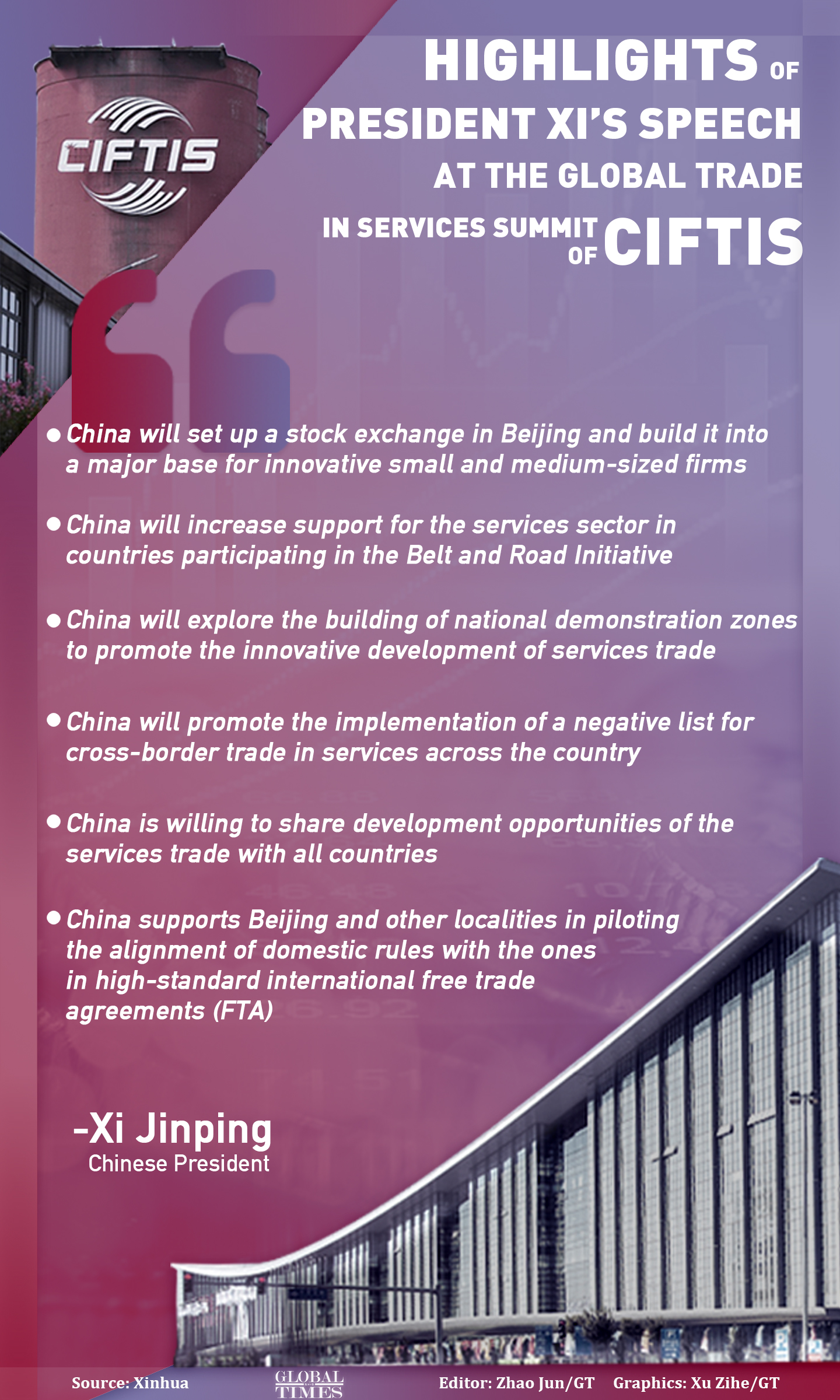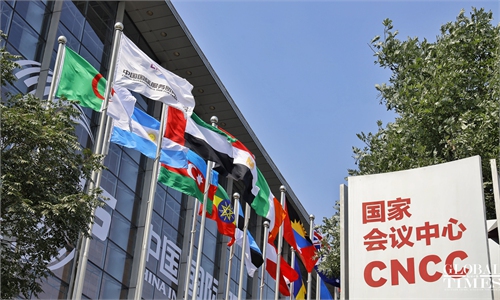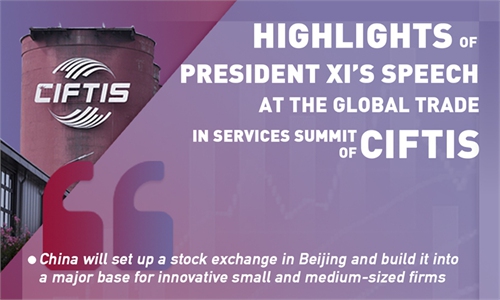China eyes bigger, bolder openness in services trade with new Beijing stock exchange

Chinese President Xi Jinping addresses the Global Trade in Services Summit of the 2021 China International Fair for Trade in Services via video on Thursday. Photo: Xinhua
China on Thursday pledged bigger and bolder efforts to open up its market for the services trade and expand the country's role as a global services hub with the top leader's announcement that a new stock exchange in Beijing and more digital trade pilot zones would be established, as it kicked off a major trade fair in Beijing that attracted widespread global participation. The latest move sent an unmistakable signal that Beijing will stick to its opening-up policies and sustainable development goals and support a global economy ravaged by protectionism and the COVID-19 pandemic.
The opening of the 2021 China International Fair for Trade in Services (CIFTIS) also illustrated China's early recovery from the COVID-19 pandemic and its robust services industry, especially in digital trade, a bourgeoning part of the services trade. The fresh pledge from the top leader also helps dispel growing concerns and even criticism of China's recent regulatory actions. A paradigm focus on trade in services will also encourage China's major services trading partners, particularly the US, to rethink their China trade policies, observers said.
"We will open up at a higher level, by implementing across the country a negative list for cross-border services trade and by exploring the development of national demonstration zones for the innovative development of trade in services," Chinese President Xi Jinping said in an address to the Global Trade in Services Summit of CIFTIS via video link on Thursday. "We will create more possibilities for cooperation by scaling up support for the growth of the services sector in Belt and Road partner countries and by sharing China's technological achievements with the rest of the world," Xi said.
Rules will be further improved for the services sector "by supporting Beijing and other localities in piloting the alignment of domestic rules with the ones in high-standard international free trade agreements and in building demonstration zones of digital trade," he stressed.
"We will continue to support the innovation-driven development of small- and medium-sized enterprises (SMEs), by deepening the reform of the New Third Board (National Equities Exchange and Quotations) and setting up a Beijing Stock Exchange as the primary platform serving innovation-oriented SMEs," Xi announced.
The new stock exchange decision charted a clear course for improving the capital market's role in providing financial support for SMEs, an official with the China Securities Regulatory Commission said shortly after the announcement of the new bourse.
A capital market and professional development platform that suits China's national conditions and would effectively serve technically advanced SMEs will be created, putting in place a regulated, transparent, open, vigorous and resilient capital market, according to the securities regulator, who praised SMEs for being able to "achieve big things" as they play a significant part in driving economic growth, fostering sci-tech innovation and creating jobs.
The A-share market is currently composed of stocks traded on the Shanghai and Shenzhen bourses, while the National Equities Exchange and Quotations in Beijing, also known as the New Third Board, acts as an over-the-counter market.

Highlights of President Xi's speech at the Global Trade in Services Summit of CIFTIS. Graphic: GT
Vibrant attendance
The annual gathering runs until Tuesday. It is being held in two venues for the first time, with the Shougang Park - one of the competition venues for the Beijing 2022 Winter Olympics - designated as the new host venue, in addition to the China National Convention Center.
The exhibition area of this year's CIFTIS totaled 130,000 square meters, up 18 percent from last year, with the participation of 153 countries and regions, an addition of five countries from the previous year, Shu Jueting, a new spokeswoman for the Ministry of Commerce (MOFCOM), told a regular press conference on Thursday.
The number of firms that registered for exhibitions and meetings exceeded 12,000, an increase of 52 percent from the year before, according to the spokesperson. The world's top 500 firms and industry heavyweights taking part in offline exhibitions accounted for 21 percent, and international participants as a percentage of the total reached 18 percent, both up substantially from the previous year.
Booth layout at the comprehensive exhibition area at the China National Convention Center, where the Global Trade in Services Summit was hosted, appeared to have been completed. The spacious exhibition hall was filled with stalls where a variety of digital services are being showcased. Huawei's self-developed Harmony OS and a wide-ranging ecosystem built around it were shown at its booth. At Bank of China's stall, a user scenario was presented, enabling visitors to get hands-on experience of digital yuan-powered consumption, according to the Global Times' observation.
US chip giant Qualcomm also brings its cutting-edge technologies to the trade show, where its 5G, artificial intelligence, extended reality and millimeter wave lineups were on display.
Qualcomm's continued attendance at CIFTIS, one of the three major events showcasing China's opening-up alongside the China International Import Expo and the Canton Fair, demonstrates its resolve to put roots in the Chinese market and push for China's global cooperation in digital services, Qualcomm said in a statement sent to the Global Times on Thursday.
This year marks the beginning of the 14th Five-Year Plan (2021-25), and China is set to implement opening-up on a larger scale, in wider areas and in a deeper manner, facilitating the integration of domestic and foreign trade and pushing for common prosperity, read the statement, in which Qualcomm said it was standing at the convergence point of a dual circulation of the domestic and international markets.

The China International Fair for Trade in Services (CIFTIS) opens in Beijing on Thursday, and is aimed at promoting deeper cooperation and wider opening-up in service trade and beyond. More than 10,000 enterprises from 153 countries and regions have signed up for this year's CIFTIS. Among them, 2,400 firms will showcase their products and services offline. Photo: VCG
Trade services strength
As the world's top trading nation in goods, the country has shown increasing promise in the services trade over the years, although it has continued to be in deficit in the sector over the past two decades.
In the first seven months of the year, China's services exports rose 23.2 percent to 1.34 trillion yuan ($207 billion) while services imports edged down 4 percent to 1.47 trillion yuan, MOFCOM data showed. The impressive growth in exports resulted in a plunge of 70 percent in the services trade deficit to 134.75 billion yuan.
The country's knowledge-intensive services exports, in particular, amounted to 704.47 billion yuan in January-July, up 15.4 percent year-on-year, making up 52.7 percent of total services exports.
Excluding travel services that remain largely grounded by the coronavirus, other parts of services trade have recovered to pre-pandemic levels, Li Jun, director of the Institute of International Trade in Services at the Chinese Academy of International Trade and Economic Cooperation, a think tank under MOFCOM, told the Global Times on Thursday.
Inspiringly, production-related flows of logistics, information and data have shown stellar growth, attesting to the country's prowess in maintaining the stability of global supply chains, particularly anti-virus medical supplies, Li said, speaking of trade in transport services that has unseated travel as the top area for trade services.
Looking ahead, the country will look to translate its digital economic strength into a rise in digital trade, a growing part of services trade, he continued, calling attention to ensuring data security amid rising awareness of digital sovereignty across the globe.
That suggests a stepped-up push for cooperation in digital trade and equipping local businesses with more advanced technologies, thereby putting them in a better position to ensure data security, observers said.
The country's open and inclusive approach to services trade is also seen as urging countries, notably the US, to abandon its sanctions-centric mentality, which only hurts its own services sector.
As Li put it, "the US, with premium services, especially high-tech services, ought to open up its market so as to create a good environment for China-US cooperation in services trade." He noted that possible moves could include easing its various curbs such as technology export controls.
Between 2001 and 2019, China's services trade with the US booked a more than seven-fold increase, while the US' services trade surplus with China surged 20 times, according to the annual report on international balance of payments released by the State Administration of Foreign Exchange in March 2020.
China overtook Canada as the largest source of services trade surplus for the US in 2015. China's services trade with the US represented 5.2 percent of the US' total in 2019, while the US' surplus with China as a proportion of its total services trade surplus topped 15 percent.




